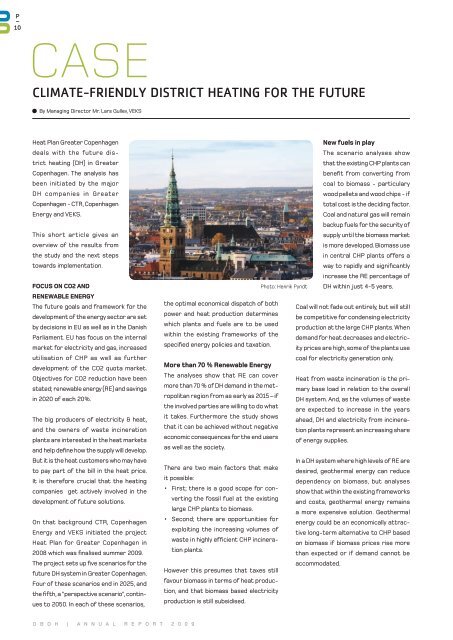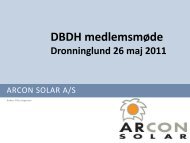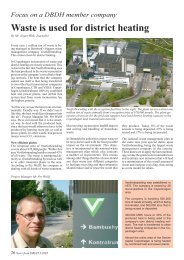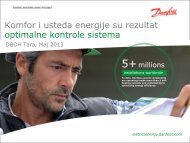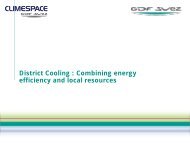Download - DBDH
Download - DBDH
Download - DBDH
You also want an ePaper? Increase the reach of your titles
YUMPU automatically turns print PDFs into web optimized ePapers that Google loves.
p_ 10<br />
ClimAtE-FRiEndly distRiCt hEAting FoR thE FutuRE<br />
By Managing Director Mr. lars gullev, VeKs<br />
Heat plan greater copenhagen<br />
deals with the future dis-<br />
trict heating (DH) in greater<br />
copenhagen. the analysis has<br />
been initiated by the major<br />
DH companies in greater<br />
copenhagen - ctr, copenhagen<br />
energy and VeKs.<br />
this short article gives an<br />
overview of the results from<br />
the study and the next steps<br />
towards implementation.<br />
Focus on co2 AnD<br />
RenewABle eneRGy<br />
the future goals and framework for the<br />
development of the energy sector are set<br />
by decisions in eu as well as in the Danish<br />
parliament. eu has focus on the internal<br />
market for electricity and gas, increased<br />
utilisation of cHp as well as further<br />
development of the co2 quota market.<br />
objectives for co2 reduction have been<br />
stated; renewable energy (re) and savings<br />
in 2020 of each 20%.<br />
the big producers of electricity & heat,<br />
and the owners of waste incineration<br />
plants are interested in the heat markets<br />
and help define how the supply will develop.<br />
But it is the heat customers who may have<br />
to pay part of the bill in the heat price.<br />
it is therefore crucial that the heating<br />
companies get actively involved in the<br />
development of future solutions.<br />
on that background ctr, copenhagen<br />
energy and VeKs initiated the project<br />
Heat plan for greater copenhagen in<br />
2008 which was finalised summer 2009.<br />
the project sets up five scenarios for the<br />
future DH system in greater copenhagen.<br />
Four of these scenarios end in 2025, and<br />
the fifth, a ”perspective scenario”, continues<br />
to 2050. in each of these scenarios,<br />
D B D H | A n n u A l R e p o R t 2 0 0 9<br />
the optimal economical dispatch of both<br />
power and heat production determines<br />
which plants and fuels are to be used<br />
within the existing frameworks of the<br />
specified energy policies and taxation.<br />
More than 70 % Renewable energy<br />
the analyses show that re can cover<br />
more than 70 % of DH demand in the metropolitan<br />
region from as early as 2015 – if<br />
the involved parties are willing to do what<br />
it takes. Furthermore the study shows<br />
that it can be achieved without negative<br />
economic consequences for the end users<br />
as well as the society.<br />
there are two main factors that make<br />
it possible:<br />
• First; there is a good scope for converting<br />
the fossil fuel at the existing<br />
large cHp plants to biomass.<br />
• second; there are opportunities for<br />
exploiting the increasing volumes of<br />
waste in highly efficient cHp incineration<br />
plants.<br />
However this presumes that taxes still<br />
favour biomass in terms of heat production,<br />
and that biomass based electricity<br />
production is still subsidised.<br />
Photo: Henrik Pyndt<br />
new fuels in play<br />
the scenario analyses show<br />
that the existing cHp plants can<br />
benefit from converting from<br />
coal to biomass - particulary<br />
wood pellets and wood chips - if<br />
total cost is the deciding factor.<br />
coal and natural gas will remain<br />
backup fuels for the security of<br />
supply until the biomass market<br />
is more developed. Biomass use<br />
in central cHp plants offers a<br />
way to rapidly and significantly<br />
increase the re percentage of<br />
DH within just 4-5 years.<br />
coal will not fade out entirely, but will still<br />
be competitive for condensing electricity<br />
production at the large cHp plants. when<br />
demand for heat decreases and electricity<br />
prices are high, some of the plants use<br />
coal for electricity generation only.<br />
Heat from waste incineration is the primary<br />
base load in relation to the overall<br />
DH system. And, as the volumes of waste<br />
are expected to increase in the years<br />
ahead, DH and electricity from incineration<br />
plants represent an increasing share<br />
of energy supplies.<br />
in a DH system where high levels of re are<br />
desired, geothermal energy can reduce<br />
dependency on biomass, but analyses<br />
show that within the existing frameworks<br />
and costs, geothermal energy remains<br />
a more expensive solution. geothermal<br />
energy could be an economically attractive<br />
long-term alternative to cHp based<br />
on biomass if biomass prices rise more<br />
than expected or if demand cannot be<br />
accommodated.


